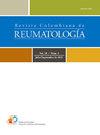哥伦比亚健康志愿者的视频毛细管镜检查结果与标准化标准
Q3 Health Professions
引用次数: 0
摘要
视频毛细血管镜检查是一种诊断程序,可以评估雷诺现象患者的甲襞微循环。很少有关于健康受试者的视频毛细血管镜检查结果的报道,哥伦比亚没有。重要的是要了解在哥伦比亚健康人群中存在的调查结果,以提供参考和确定疾病患者的异常情况。我们的目的是描述来自哥伦比亚人群的健康志愿者的标准化定性和定量视频毛细血管镜检查结果和社会人口学特征。材料和方法在哥伦比亚波哥大的西蒙Bolívar和哥伦比亚国立大学医院进行了一项横断面描述性研究。18岁以上的健康成人志愿者被纳入研究。从每只手的第二到第五指,每个手指拍两张照片。进行了一项试点测试,以完善程序并建立测试评估者之间的协议,其中kappa一致性指数用于估计毛细血管密度,毛细血管扩张,巨毛细血管,异常形态和无血管区域的发现。随后,测量静脉袢、动脉袢、根尖部分、毛细血管间距、毛细血管密度、毛细血管扩张、巨毛细血管、无血管区,并描述毛细血管形态。最后,通过快速诊断流程进行毛细管镜诊断。结果共进行视频毛细血管镜检查101例。参与者年龄20-62岁(平均31岁)。59名女性和42名男性。共分析了1611张200倍的照片。在毛细血管密度、毛细血管扩张、微出血和异常形状方面,两名观察者的一致性非常好。各指标的平均值为:毛细血管密度8.2支/mm,根尖直径14.1 μm,动脉袢10.8 μm,静脉袢13.7 μm,毛细血管间距147 μm。对10855根毛细血管进行形态学评价。以发夹形态居多,占58.8%,其次为交叉30.2%,弯曲10.4%,异常形态占0.48%。未见无血管或巨毛细血管区。53例(182例)有毛细血管扩张,占所分析毛细血管的1.7%(根尖直径中位数:23.3 μm)。16例患者出现微量出血,多为含铁血黄素。使用Fast-Track算法和标准化标准的毛细血管镜诊断在整个样本中为I类(非硬皮病模式),101个视频毛细血管镜分析中有67个(66.3%)观察到非特异性异常。结论在我们的队列健康人群中,最常见的发现是非特异性的孤立异常,但当应用Fast-Track算法和标准化标准时,不符合硬皮病模式。除了高达36 μm的扩张外,含或不含含铁血黄素的微出血,罕见的毛细血管密度异常和降低。在这些健康受试者中未见血管或巨毛细血管带。本文章由计算机程序翻译,如有差异,请以英文原文为准。
Videocapillaroscopy findings in a Colombian population of healthy volunteers with standardization criteria
Introduction
Videocapillaroscopy is a diagnostic procedure that allows an assessment of the microcirculation in the nailfold of patients with Raynaud's phenomenon. There are few reports of videocapillaroscopic findings in healthy subjects, none in Colombia. It is important to know the findings that exist in the Colombian healthy population to have a reference and define abnormalities in people with diseases.
Objective
Our aim was to describe the standardized qualitative, quantitative videocapillaroscopic findings and the sociodemographic characteristics in healthy volunteers from a Colombian population.
Materials and methods
A cross-sectional descriptive study was conducted at the Simon Bolívar and Hospital Universitario Nacional de Colombia in Bogota, Colombia. Healthy adult volunteers over 18 years of age were included in the study. Two images were taken per finger from the second to fifth of each hand. A pilot test was conducted to refine the procedure and establish the agreement between the evaluators of the test, in which a kappa concordance index was estimated for the findings of capillary density, presence of dilated capillaries, megacapillaries, abnormal morphologies and avascular areas. Subsequently, measurements of the venous loop, arterial loop, apical portion, intercapillary distance, capillary density, presence of dilated capillaries, megacapillaries, avascular zones, and description of capillary morphology were performed. Finally, a capillaroscopic diagnosis was issued by Fast-track flowchart.
Results
One hundred one videocapillaroscopy studies were performed. The age range of the participants was 20–62 years (average 31 years). 59 women and 42 men. A total of 1611 photographs at 200× were analyzed. Agreement between the two observers was excellent for capillary density, dilated capillaries, microhemorrhages and abnormal shapes. The average of each the findings was as follows: capillary density of 8.2 capillaries/mm, apical diameter 14.1 μm, arterial loop 10.8 μm, venous loop 13.7 μm, and intercapillary distance 147 μm. Morphology was evaluated in 10,855 capillaries. The predominant morphology was hairpin with 58.8%, followed by crossed 30.2% tortuous 10.4%, and abnormal forms corresponded to 0.48% of the sample. No avascular or megacapillary zones were documented. In 53 individuals, there were some dilated capillaries (182), corresponding to 1.7% of the capillaries analyzed (median of apical diameter: 23.3 μm). Microhemorrhages was found in 16 volunteers, most of them hemosiderin content. The capillaroscopic diagnosis using the Fast-Track algorithm and standardization criteria were category I (a non-scleroderma pattern) in the entire sample, non-specific abnormal findings were observed in 67 (66.3%) of the 101 videocapillaroscopy analyzes.
Conclusions
In healthy people of our cohort, the most frequent finding was nonspecific isolated abnormalities, but do not conform a scleroderma pattern when Fast-Track algorithm and standardization criteria are applied. In addition to ectasias up to 36 μm, microhemorrhages with or without hemosiderin, rare abnormal and decreased capillary densities. Avascular or megacapillary zones were uncommon observed in these healthy subjects.
求助全文
通过发布文献求助,成功后即可免费获取论文全文。
去求助
来源期刊

Revista Colombiana de Reumatologia
Medicine-Rheumatology
CiteScore
0.80
自引率
0.00%
发文量
92
期刊介绍:
The Colombian Journal of Rheumatology (Revista Colombiana de Reumatología) is the official organ of the Colombian Association of Rheumatology (Asociación Colombiana de Reumatología) and the Central American, Caribbean and Andean Association of Rheumatology (Asociación Centroamericana Caribe Andina de Reumatología) - ACCA. It was created in December 1993 with the purpose of disseminating scientific information derived from primary and secondary research and presenting cases coming from the practice of Rheumatology in Latin America. Since its foundation, the Journal has been characterized by its plurality with subjects of all rheumatic and osteomuscular pathologies, in the form of original articles, historical articles, economic evaluations, and articles of reflection and education in Medicine. It covers an extensive area of topics ranging from the broad spectrum of the clinical aspects of rheumatology and related areas in autoimmunity (both in pediatric and adult pathologies), to aspects of basic sciences. It is an academic tool for the different members of the academic and scientific community at their different levels of training, from undergraduate to post-doctoral degrees, managing to integrate all actors inter and trans disciplinarily. It is intended for rheumatologists, general internists, specialists in related areas, and general practitioners in the country and abroad. It has become an important space in the work of all rheumatologists from Central and South America.
 求助内容:
求助内容: 应助结果提醒方式:
应助结果提醒方式:


